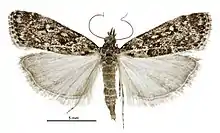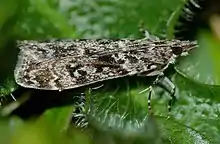| Eudonia philerga | |
|---|---|
 | |
| Female | |
 | |
| Male holotype | |
| Scientific classification | |
| Domain: | Eukaryota |
| Kingdom: | Animalia |
| Phylum: | Arthropoda |
| Class: | Insecta |
| Order: | Lepidoptera |
| Family: | Crambidae |
| Genus: | Eudonia |
| Species: | E. philerga |
| Binomial name | |
| Eudonia philerga | |
| Synonyms[2] | |
| |
Eudonia philerga is a species of moth of the family Crambidae.[3] This species was first described by Edward Meyrick. It is endemic to New Zealand and is found throughout the country. E. philerga is regarded as being common. Larvae feed on moss and the adults have been observed on the wing more frequently from October to April. Adult moths are attracted to light.
Taxonomy
This species was named Scoparia philerga by Edward Meyrick in 1884.[4][2] Meyrick gave a detailed description of the adult moth in 1885.[5] George Hudson discussed and illustrated this species his 1928 publication The butterflies and moths of New Zealand.[6] In 1988 John S. Dugdale placed this species in the genus Eudonia.[2] The male holotype specimen, collected at Lake Wakatipu, is held at the Natural History Museum, London.[2]
Description
.jpg.webp)

The larvae of E. philerga are about 1⁄2 inch long and are coloured a dull dark green with head that is reddish brown.[7][6] They have large blackish green protuberances.[7] This colouration provides excellent camouflage as, when still, larvae are difficult to see amongst their host plant.[7] The pupa is formed amongst moss and is surrounded by a thin cocoon.[7] Hudson described the adult of the species as follows:
The expansion of the wings is a little over 3⁄4 inch. The fore-wings are rather narrow, dull white, speckled and obscurely marked with black. There is a short thick black streak at the base, the first line is white, obscurely margined with black towards the termen; the orbicular and claviform form an obscure black patch; the reniform is 8-shaped white margined with black and touching a small black mark on the costa; the second line is white, distinct, edged with black, the terminal space is black except the sub-terminal line, which is frequently broken and often touches the second line near the middle; there is a terminal row of white dots. The hind-wings are pale yellowish-white strongly shaded with grey towards the termen. The cilia of all the wings are dull white with a darker line.[6]
Hudson noted that when at rest on trees or rocks, the colouration of the adult moth also provides excellent camouflage, safeguarding it from predators.[6]
Distribution
This species is endemic to New Zealand.[1][8] It is found throughout the country and is regarded as being common.[7]
Behaviour
It has been hypothesised that this species has two broods and that adults of the autumn generation hibernate as adults have been taken by light trapping during winter.[7] Adults are on the wing through out the year though more frequently from October to April.[7] The adults of this species are attracted to light.[7]
Host species
The larvae of this species feed on mosses found on wood.[9][10]
Threats
A specimen of this species has been tested for Wolbachia infection.[11] However the result of this test was negative.[11]
References
- 1 2 "Eudonia philerga (Meyrick, 1884)". www.nzor.org.nz. Landcare Research New Zealand Ltd. Retrieved 26 January 2018.
- 1 2 3 4 John Stewart Dugdale (23 September 1988). "Lepidoptera - annotated catalogue, and keys to family-group taxa". Fauna of New Zealand. Department of Scientific and Industrial Research. 14: 157. doi:10.7931/J2/FNZ.14. ISSN 0111-5383. Wikidata Q45083134.
- ↑ Gordon, Dennis P., ed. (2010). New Zealand inventory of biodiversity: Kingdom animalia: chaetognatha, ecdysozoa, ichnofossils. Vol. 2. p. 458. ISBN 978-1-877257-93-3. OCLC 973607714. OL 25288394M. Wikidata Q45922947.
- ↑ Edward Meyrick (1884). "Descriptions of New Zealand Microlepidoptera. IV. Scopariadae". New Zealand Journal of Science. 2: 235. Wikidata Q113372586.
- ↑ Edward Meyrick (1885). "Art. XI. — Descriptions of New Zealand Micro-Lepidoptera". Transactions and Proceedings of the New Zealand Institute. 17: 81–82. ISSN 1176-6158. Wikidata Q113379604.
- 1 2 3 4 George Vernon Hudson (1928), The butterflies and moths of New Zealand, Illustrator: George Hudson, Wellington: Ferguson and Osborn Limited, p. 183, LCCN 88133764, OCLC 25449322, Wikidata Q58593286
- 1 2 3 4 5 6 7 8 David Edward Gaskin (1966). "The butterflies and common moths of New Zealand". New Zealand: 166–167. Wikidata Q115000559.
- ↑ "Eudonia philerga (Meyrick, 1884)". biotanz.landcareresearch.co.nz. 27 July 2015. Retrieved 2022-11-05.
- ↑ "Eudonia philerga (Meyrick, 1884) - Invertebrate herbivore report". plant-synz.landcareresearch.co.nz. Retrieved 2019-07-23.
- ↑ Hamish J. H. Patrick; Mike H. Bowie; Barry W. Fox; Brian H. Patrick (2011). "The moths of Quail Island (Ōtamahua): a faunal comparison of an island under restoration with other sites on Banks Peninsula". New Zealand Natural Sciences. 36. doi:10.26021/583. ISSN 0113-7492. Wikidata Q97665452.
- 1 2 Renate Wöger; Roland Wöger; Matthias Nuss (7 July 2020). "Spatial and temporal sex ratio bias and Wolbachia-infection in New Zealand Crambidae (Lepidoptera: Pyraloidea)". Biodiversity Data Journal. 8: e52621. doi:10.3897/BDJ.8.E52621. ISSN 1314-2828. PMC 7360630. PMID 32733140. Wikidata Q98177304.